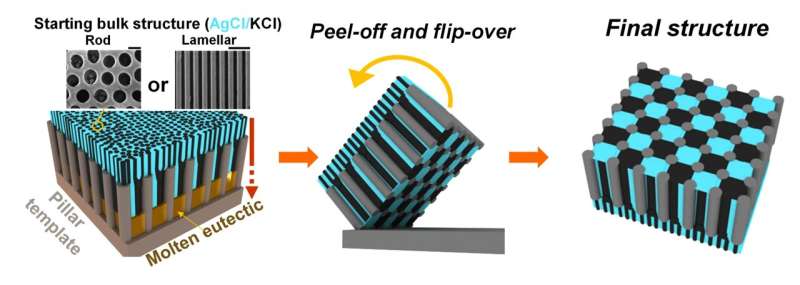
Schematic illustration of the template-directed eutectic solidification process. Liquid (gold) AgCl (cyan)-KCl (black) eutectic system solidifies through the pillar template. Credit: The Grainger College of Engineering at University of Illinois Urbana-Champaign
Self-assembled solidifying eutectic materials directed by a template with miniature features demonstrate unique microstructures and patterns as a result of diffusion and thermal gradients caused by the template. Despite the template trying to force the material to solidify into a regular pattern, when the template carries a lot of heat it also can interfere with the solidification process and cause disorder in the long-range pattern.
Researchers at the University of Illinois Urbana-Champaign and the University of Michigan Ann Arbor have developed a template material that carries almost no heat and therefore stops heat transfer between the template material itself and the solidifying eutectic material. They accomplished this by forming the template from a material with very low thermal conductivity, ultimately resulting in highly organized self-assembled microstructures.
The results of this research were recently published in the journal Advanced Materials.
“The key novelty of this research is that we carefully controlled the flow of heat. By controlling the flow of heat, the pattern becomes far better and more regular than before because we’re controlling more of the parameters. Previously, the template controlled the flow of atoms, but the heat flows were uncontrolled,” says Paul Braun, a professor of materials science and engineering and director of the Materials Research Laboratory, who led this research along with postdoctoral researcher Sung Bum Kang.
Eutectic materials are a homogeneous mixture that have a melting point that is lower than the melting point of either constituent. Common examples of eutectic systems include solder (a mixture of lead and tin) and mixtures of salt (sodium chloride) and water. When eutectic mixtures are cooled from the liquid phase, they separate into two materials that form a pattern at the solidifying front.
The material doesn’t separate into just two large layers. Instead, it forms structures including a multi-layered structure (lamellar), like a tiered cake, a rod-like structure or even more complex structures. The resulting microstructure of the material, however, is only well-ordered over short distances. Instabilities that arise in the self-assembly process lead to defects in the microstructure and affect the properties of the resulting solid material. For many applications, such as optics or mechanics, very good order over long distances is required.
The solidification process can be controlled by a template consisting of pillars that act as barriers to the movement of atoms and molecules. This forces the structure to form a more regular pattern when it solidifies. But the issue, Braun explains, is that the pillars carry a lot of heat, and instead of having a flat, solidifying front, the shape of the front becomes complex. This leads to irregular patterns and long-range disorder.
“We figured out how to make the pillars so that they were really good insulators,” Braun says. “So all of the heat is only flowing through the material that’s solidifying. The template is now only acting as a barrier to the flow of atoms, but almost no heat is moving between the solidifying material and the template.”
The researchers explored template materials with lower thermal conductivities than the eutectic system and found that low thermal conductivity template material resulted in highly organized microstructures with long-range order. Specifically, they used porous silicon (essentially a silicon foam) that is at least 100 times less thermally conductive than crystalline silicon. The template material’s low thermal conductivity minimizes the flow of heat in the “wrong” direction.
“The thermal conductivity of the template is a critical factor in determining the rate of heat transfer during the solidification process,” Kang says. “The porous silicon we used for the templates has a low thermal conductivity and led to about 99% uniformity of the unit cells of the structure.”
In comparison, with higher thermal conductivity crystalline silicon pillars, the expected pattern is only present in 50% of the unit cells.
“This means we can design eutectic materials with highly predictable and consistent properties. This level of control is crucial for applications where uniformity directly impacts performance,” Kang says.